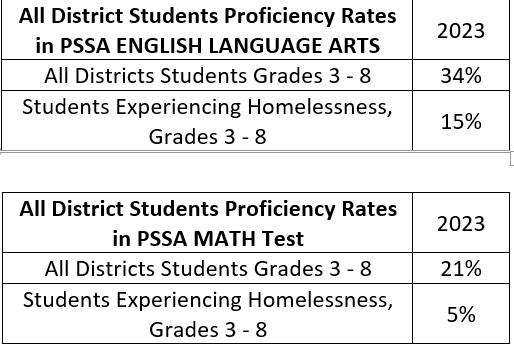Three Metrics on Students Experiencing Homelessness
School is starting ...
Past advocacy for students experiencing homelessness has primarily focused on the increasing numbers of these students rather than on key academic factors.
This focus may have led to a lack of discussion on how to improve key indicators such as truancy, academic achievement, and suspensions.
The number of homeless students has been rising every year for at least the past fifteen years, which is alarming. In Philadelphia, increases have ranged from 4% to 15% compared to previous years. While this is significant, other indicators have received little to no attention.
Aggregate measures of chronic truancy, suspensions, and academic achievement for students experiencing homelessness have historically been worse than those of their housed peers in Philadelphia. We have not examined data from other regions for this report.
According to a recent School District report, Philadelphia students experiencing homelessness have lower rates of academic achievement on standardized tests, higher rates of chronic truancy, and higher rates of suspensions compared to their housed peers.
The charts above provide insight into these key trends but do not offer recommendations to address these figures. More information is certainly needed.
However, discussions about the necessary actions to address these concerns are lacking. What should be done, and how? How can the City come together to change these negative metrics?
Homeless students are found in almost every school, with numbers ranging from 1 to over 100. Should each school be given resources to target these students? How can this be done successfully and efficiently? Assuming there is no funding to hire new personnel, which current school staff should take on this work? Are there other pressing needs that would limit a focus on homeless children?
One effort by the School District is the utilization of the “community school” concept. According to the City of Philadelphia’s website, each of the 20 community schools has a full-time coordinator responsible for sustained community involvement, coordination of services, and collaboration with school principals and staff. The Community Schools initiative is funded through the Philadelphia Beverage Tax and is a partnership between the District and the City of Philadelphia. While basic information is available, detailed information is scarce. Interviewing staff at these schools is beyond our scope but would provide much-needed understanding.
A privately-funded research/evaluation process could improve our understanding and offer recommendations. Capturing the voices of parents, students, school administrators, teachers, and others would be helpful.
What are your suggestions?





I suggest partnering with the schools of social work to provide field placements at these community schools to target homeless students. They could also do research